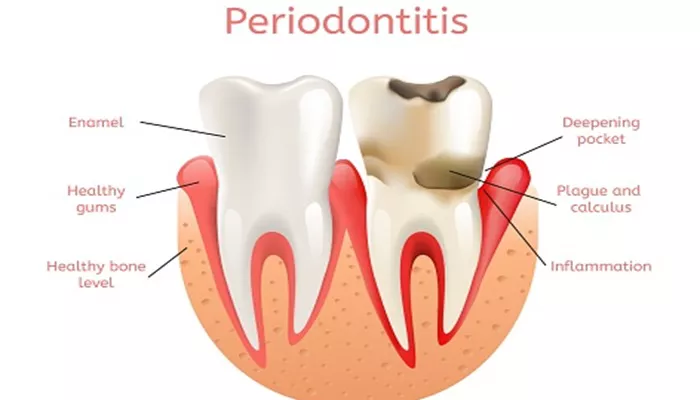Periodontal disease, also known as gum disease, is a chronic inflammatory condition affecting the tissues surrounding the teeth. It ranges from mild gingivitis to severe periodontitis, which can lead to tooth loss if untreated. This condition is primarily caused by bacterial infections that lead to inflammation and damage to the gum tissue and bone structures supporting the teeth. Understanding how to combat and manage periodontal disease is crucial for maintaining oral health.
Causes of Periodontal Disease
Before exploring treatment methods, it’s essential to understand the causes of periodontal disease. The primary culprits include:
Bacteria: The primary cause of periodontal disease is the accumulation of bacterial plaque on the teeth. These bacteria release toxins that irritate the gums, leading to inflammation and infection.
Poor Oral Hygiene: Inadequate brushing and flossing allow plaque and tartar to build up, increasing the risk of gum disease.
Smoking and Tobacco Use: Tobacco products impair gum health, making the gums more susceptible to infection.
Genetic Predisposition: Some individuals may be genetically predisposed to periodontal disease.
Hormonal Changes: Conditions such as pregnancy, menopause, and puberty can affect gum health.
Medical Conditions: Diseases like diabetes and certain medications can influence the severity of periodontal disease.
SEE ALSO: How to Evaluate Periodontal Disease
Effective Treatments for Periodontal Disease
Combating periodontal disease requires a multi-faceted approach, including both professional treatments and at-home care. Here’s a comprehensive look at the methods used to kill or control periodontal disease:
Professional Treatments
Scaling and root planing is a deep cleaning procedure performed by a dental professional. It involves the removal of plaque and tartar from above and below the gum line. Scaling eliminates the bacterial deposits, while root planing smooths the tooth roots, making it harder for bacteria to adhere. This procedure helps reduce inflammation and allows the gums to heal and reattach to the teeth.
Antibiotic Therapy
Antibiotic therapy may be prescribed to help eliminate bacteria causing periodontal disease. This can include topical antibiotics applied directly to the gums or systemic antibiotics taken orally. Commonly used antibiotics include doxycycline and minocycline, which can reduce bacterial levels and inflammation.
Periodontal Surgery
In cases of severe periodontal disease, periodontal surgery may be necessary. Procedures such as flap surgery, bone grafts, or guided tissue regeneration are used to repair and regenerate the damaged tissues and bone structures. These surgeries help reduce pocket depth, regenerate lost bone, and restore gum health.
Laser Therapy
Laser therapy is a modern treatment option that uses focused light to remove diseased tissue and bacteria from the gums.
This method can be less invasive and more precise than traditional methods. It promotes faster healing and can be used in conjunction with other periodontal treatments.
Oral Probiotics
Oral probiotics are beneficial bacteria that can help restore the natural balance of oral flora. They can be used as an adjunct to traditional treatments to support gum health and reduce inflammation.
At-Home Care
Proper Brushing and Flossing
Maintaining a rigorous oral hygiene routine is crucial in managing and preventing periodontal disease. Brushing twice a day with fluoride toothpaste and flossing daily helps remove plaque and prevent tartar buildup. Using an antimicrobial mouthwash can further reduce bacterial levels in the mouth.
Regular Dental Check-Ups
Regular dental check-ups are essential for monitoring gum health and preventing the progression of periodontal disease.
Professional cleanings and exams help identify and address issues before they become severe.
Healthy Diet
A balanced diet rich in vitamins and minerals supports overall gum health. Foods high in antioxidants, such as fruits and vegetables, can help reduce inflammation and support the immune system. Avoiding sugary and acidic foods also helps prevent plaque buildup.
Smoking Cessation
Quitting smoking is one of the most effective ways to improve gum health and reduce the risk of periodontal disease.
Tobacco use significantly impairs gum tissue and can hinder the healing process.
Managing Medical Conditions
Controlling underlying medical conditions such as diabetes is crucial for managing periodontal disease. Proper management of these conditions can help reduce inflammation and improve gum health.
Preventive Measures
Use of Dental Sealants
Dental sealants are protective coatings applied to the chewing surfaces of the back teeth. They help prevent plaque buildup and decay, reducing the risk of periodontal disease.
Custom Mouthguards
For individuals with bruxism (teeth grinding), using a custom mouthguard can protect the teeth and gums from damage and reduce the risk of periodontal issues.
Education and Awareness
Patient education plays a vital role in preventing periodontal disease. Understanding the importance of oral hygiene, recognizing early symptoms, and seeking timely dental care are essential for maintaining gum health.
Conclusion
Periodontal disease is a serious condition that requires a comprehensive approach to treatment and management. By combining professional dental care with diligent at-home practices, individuals can effectively combat and control periodontal disease. Regular dental check-ups, proper oral hygiene, a healthy diet, and avoiding risk factors such as smoking are crucial components in killing periodontal disease and maintaining overall oral health.

